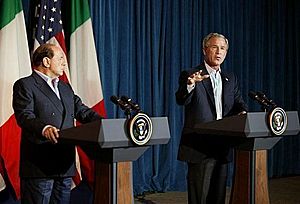Center-right facts for kids
Centre-right politics lean to the right of the political spectrum, but are closer to the centre. Parties of the centre-right generally support liberal democracy, capitalism, the market economy, private property rights, and a modest welfare state. They support conservatism and economic liberalism and oppose socialism and communism.
Ideologies characterised as centre-right include liberal conservatism and some variants of liberalism and Christian democracy, among others. The economic aspects of the modern centre-right have been influenced by economic liberalism, generally supporting free markets and limited government spending.
Historical examples of centre-right schools of thought include One Nation Conservatism in the United Kingdom, Red Tories in Canada, and Rockefeller Republicans in the United States. New Democrats in the United States also embraced several aspects of centre-right policy, including balanced budgets, free trade, deregulation, and welfare reform. These ideological factions contrast with far-right policies and right-wing populism. They also tend to be more supportive of cultural liberalism and green conservatism than right-wing variants.
According to a 2019 study, centre-right parties had approximately 27% of the vote share in 21 Western democracies in 2018. This was a decline from 37% in 1960.
See also
 In Spanish: Centroderecha política para niños
In Spanish: Centroderecha política para niños


